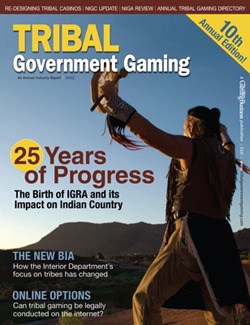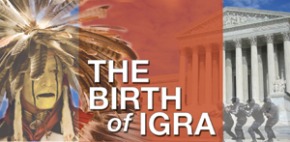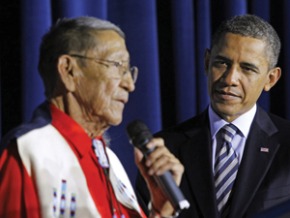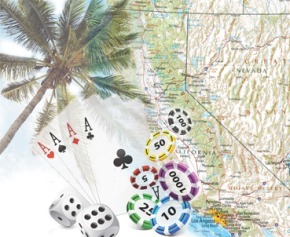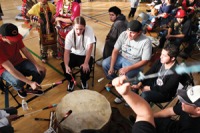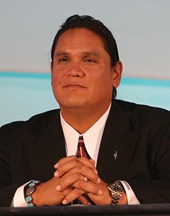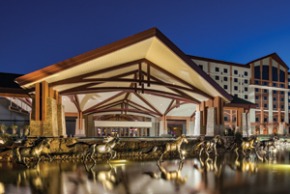
Tribal gaming is entering a unique crossroads. Three prosperous decades have lured abundant competition and sparked the need to revamp.
This is a logical path. Tribal gaming strength speaks volumes, with estimated revenues approaching $28 billion. Disciplined self-financing helped tribes withstand the freefall of the Great Recession far better than non-native properties over the past five years. And some tribes have purchased land outside their reservations, hoping to survive court battles or work with municipalities to build more competitive casinos.
On the flip side, saturation lurks. There are approximately 400 casinos operated by tribes in the United States. Blended with non-native properties, competition continually sharpens. Online poker, off-track betting, sports betting and state lotteries all bid for the attention of the bettor.
Go ahead, find the rare, non-congested market. It’s almost impossible to do.
Nobody should stand pat, but what’s the smart choice between renovation and building new? Does one plan for several years or for just a couple?
Several renowned architects and engineers, with longtime ties to Indian gaming, have weighed in. They outline the best bang for the building buck.
Amenities: The Chief Argument
Thalden Boyd Emery principal Chief Boyd knows what works in Indian Country.
With more than 50 years of architectural experience, Boyd has a unique insight to numerous tribal entities, including his own, the Cherokees. Many of them unfold in Oklahoma, where Thalden Boyd Emery has a Tulsa branch. Boyd considers garages, RV parks, theaters and rooms excellent returns on investment, while golf courses often under-achieve.
“The tribes have a good sense of what they are building and the business reasons behind it,” he says. “You get this expansion and refurbishing question all the time in Oklahoma, where you have over 100 casinos. We have one spot in northeast Oklahoma which is the 13th casino within a 20-minute drive.
“We get asked by customers, ‘When are you going to stop building?’ The answer is ‘when they stop donating to the tribe,’” he laughs.
Boyd helps tribes understand the amenity pecking order. He says parking garages have an excellent payback period of just over a year, even without charging customers. The garage may cost $10,000 per space. Boyd estimates the average space contributes $22 a day to the floor. In one year, that spot has returned 74 percent of its building cost. Early in year two, the parking space now constitutes profit. Even a moderate-sized, 100-car garage contributes handsomely to the bottom line by year two.
Given the low cost of construction, the garage is the key amenity player. But RV parks in Indian Country come in a strong second. Boyd indicates that each space may cost an average of $15,000 to build, but operators can charge for it and recapture $10,000 a year. Each spot also delivers to the bottom line by the second year. That doesn’t even include what the customer drops inside the casino.
Hotel rooms also play a strong role. When occupied, they pay down the cost of construction. If empty, they can be used to lure players into extending their stay. Players not only remain on property, but have been psychologically massaged by the freebie. Boyd says new hotel rooms pay for themselves within two years.
Movie theaters? They may average $6,000 per seat to construct, but daily revenue will produce a break-even point in just over two years. Then, it’s all cinematic “cha-ching.”
Golf courses, however, are overrated. Boyd indicates the average facility costs $7 million to construct. Then, it must be staffed and maintained. The costs of water and electricity are staggering in this area, and the course only operates during daylight. It is hampered by significant downtime.
It may take a couple decades to recoup the price of this “going green” amenity. Operators must decide whether their goals are short-term, as in return on investment, or long term, to drive an image of splendor, magnificence, etc.
Cuningham Displays Versatility
Minnesota-based Cuningham Group, which has risen alongside Indian gaming since the early 1990s, embodies the amenity concept from several directions. It has orchestrated large-scale endeavors like the $650 million re-creation of the Harrah’s Cherokee Casino Resort in North Carolina. It also worked mid-sized expansions in the $100 million-$150 million range via a new hotel tower for the Potawatomi Bingo Casino in Milwaukee, Wisconsin, and a resort hotel and convention center for the Isleta Casino in Albuquerque, New Mexico.
Cuningham principal Tom Hoskens offers his own rating of amenities, which is tied to important points. One is the concept of periodic refurbishing. This is the engine that drives the entire financial resort.
“What I think is trending is the idea of breaking out of the box,” he says. “You have ended up with a lot of casinos that seem very regimented, like they were laid out by a drill sergeant. It bores people on end. It’s an excellent idea to change the amenities.”
Sometimes, a tweak works wonders.
“There are a lot of different ways to do that, and most of the time it depends on the competition around a property,” he says. “I like to see pieces of it every year. This takes care of your customer who comes there continually. You always want to be giving that customer a little excitement. That customer likes to think you are always looking to improve the facility for him. You can change out the carpets, or do something with the pathways around you.”
Like Boyd, Hoskens advances the concept of covered garages near the property. They are inexpensive to build and maintain, and, because they are free, they give customers their first comp before leaving their vehicles. The garage must constitute easy walking distance to the casino and be covered to guard against rain and snow.
New hotels and convention centers attack another industry prize, midweek traffic. Hoskens says most of Cuninghams’s newest projects contain this component. They give customers a venue in which to socialize. Their extended stays make gaming a more leisurely activity.
Local properties share the lessons learned from operators like Station in Las Vegas: provide family entertainment like bowling alleys and theaters.
“Native American properties have adopted the same philosophy,” he indicates. “You can create a wonderful entertainment opportunity when people come in. The parents can drop their kids off at the cinema, and with someone to watch them, go play for two and a half hours, pick up the kids and go home. Or you can do a bowling league, followed by some gambling. Amenities like that give you a real return on investment.”
They also make it easy for patrons to return.
Then comes the mystique factor, placed into the subconscious realm of economic planning: create a buzz. This is a dynamic recognized from casino boardrooms and architectural plans to the entertainment stage.
If considering an addition, Hoskens says casinos need to create a big bang. It could be a landscaped pool or nightclub, a pool by day and club by night. A concept like this creates a buzz and foot traffic.
Outdoor amphitheaters also rank strongly for investment return. They host high-quality entertainment acts, which can both draw customers and create long-term revenue.
Finally, he favors a retail chain connected to or nearby the property. Customers can’t help but wander from the store to the gaming floor.
Worth The Investment
Tribal entities have been savvy with their finances, according to Brian Fagerstrom, president of Denver-based WorthGroup Architects. The company finished three significant projects in late 2012—renovation and expansion for Harrah’s Ak-Chin Casino in Phoenix, the Cherokee Hard Rock in Tulsa and the Choctaw Pocola in Oklahoma. It also built new for Jena Choctaw Casino in Louisiana, which opened in February.
A common theme ran through all properties.
“All the projects are cash-funded,” Fagerstrom says. “None of these has financing associated with it. That tells a huge story about how the tribes have been able to develop their properties at a pace in which they have cash flow. The smart ones are able to figure it out without ever having to finance.”
Harrah’s Ak-Chin does have capital funding from itself. The property amassed an improvement budget over the years and spent it. When expanding, they seek the smart packages of additional gaming space, resort luxury and a tilt toward the younger audience.
“What’s trending now is how entertainment brings all the amenities together,” Fagerstrom asserts. “Entertainment is more and more prevalent in how the design is implemented.
“Beyond the restoration, beyond the gaming part, and beyond the hotel component, you find that entertainment is at the forefront of the architectural design.”
Its form embraces younger demographics. Many operators proclaim the benefit of “gaming lounges” where people with smart phones, mobile apps and a fine grasp of technology can gamble.
“It’s not traditional entertainment,” Fagerstrom says. “You don’t see a band and listen to a lounge act in all of them. Much of this is about, ‘How can I sit and use my smart phone? How can I get information? Where can I sit down with a drink, be part of the gaming action and be relaxed?’
“Part of it is technology, part of it is equipment and part of it is flexibility. As places continue to grow, gaming, hospitality and the amenities help properties distinguish themselves.”
Take the new lounge at Hard Rock. Although the project was noted for its suites, it included a stunning new lounge-in-the-round. Comfortable chairs with sleek red backs adorn the floor. A circular design, draped in blue, marks the wall and ceiling. The curves create the sense of wide-open space. Several mid-sized screens display an abundance of sporting events. Actual scores of games can be seen on a ticker running across the top of the bar. Patrons can sit, order drinks and watch events they may have even wagered upon online. The facility even creates a good environment for a DJ.
This amenity, directed at younger players, complemented the overall renovation project. Hard Rock added the all-suite tower of approximately 100 rooms with the intention of pleasing high-end players.
A thrill factor usually accompanies the renovation. While properties upgrade to stay competitive, they often do something new to make a statement.
The Pocola project encompassed both. The operators did not have a hotel on the property. They added one, re-branded the entire facility, created a resort look and went from a two-story casino building to an eight-story structure.
It was an important leap, because this property competes with about 30 operators in a one-hour radius.
“All of this created a new image for their location,” Fagerstrom says. “They got four-for-one (four benefits to one project), including the extra capacity for gaming.”
As for Choctaw Pines, the operators skipped entry-level positioning. They sought a mid-sized, impressive casino which figured to hit the ground running. The building is the closest gaming property to an area of 180,000 people, Fagerstrom says.
It opened as a casino and the hotel is already planned. Fagerstrom indicates that the tribe sought high-end construction, which enables flexibility and future expansion.
SOSH Scores
Tribes pay attention both to finance and flexibility, which create interesting expansion discussions.
“With the economy having gone through freefall over the past four to five years, we are finding that our clients look for ways to renovate on much tighter budgets,” says Tom O’Connor, a principal at SOSH Architects in Atlantic City. The company has extensive inroads with the Native American community.
“Whether it’s a hotel room refresh or a restaurant re-branding, owners and their funding sources are looking long and hard at the bottom line,” O’Connor says. “Prioritizing features and materials, phasing construction schedules and (the much dreaded) ‘value engineering’ are the new normal. The goal is to not have the cost-conscious decisions be apparent.”
It can be done. The mindset often means smaller outlays for everything from the energy-efficient HVAC system to light dimming, audio video systems and railings. Off-the-shelf carpeting, simplified landscape design features and less durable exterior building materials can also be used to reduce cost.
Then there are faux finishes, the paint and wall coverings that mimic (especially from a distance) expensive wood, marble and stone finishes. These are the wrinkles that an architect would notice, but the players would not.
Master planning becomes more critical as Native American casinos morph into world-class resorts, with amenities expected from destination properties, O’Connor says. Money becomes a big subject for operators thinking several years ahead.
This concept was practically unheard of a few years ago. An expansion involving added gaming space practically ensured a huge return. Yet, the crunch of competition in this challenged economy shifts the landscape.
Expansion projects that once appeared limitless in scope and cultural design features must be become cost-effective. Architects share the conference table with accountants.
“That’s always a battle in the business environment,” O’Connor says. “If you think about the hard times we had in the ’90s, General Motors was being run by the bean counters. They ran the company into the ground. You need to have a fine balance between project cost and design.
“Quite often, you will have the bean counter at the meeting, trying to tamper down anything they perceive as too expensive. But you also have a real good executive at that meeting who understands the value good design brings to a project.”
Somewhere between those perspectives, projects become finalized.
SOSH’s key tribal associations include the Senecas in New York and the Seminoles in Florida. The company performs varied expansion projects along with a brand new $300 million property for the Seminoles set open later this year at Ohio’s Northfield Park racetrack.
O’Connor says businesses often can renovate for 70 cents on the dollar compared to building new. That gives tribes distinct but different methods to create their image.
One popular concept is creating a long shelf life for an expansion by building for future considerations. SOSH recently prepared a five- to 10-year master plan for Fantasy Springs Golf Resort and Casino in Indio, California. The original property had expanded without planning future venues to complement the changeover from casino to resort.
The SOSH master plan would provide phased expansions to the hotel towers and pool complexes, secluded casitas, an 18-hole golf course, a retail town center, additional restaurant/entertainment venues and a new, enlarged casino. The first phase of restaurant, bar and casino renovations was recently completed. The master plan provides a road map but remains flexible to accommodate future considerations.
Hnedak Bobo: A Varied Approach
Many tribal gaming operators reposition their properties to stay fresh and build greater awareness with customers, according to Dike Bacon, principal for Memphis-based Hnedak Bobo Group.
Some opt for the heavy-hitting implications of branding.
“One such strategy tribes are considering is the drawing power of recognized national brands,” he indicates. “They are powerful motivators for customers and can significantly enhance a property’s ability to stay top-of-mind. Bringing a national brand to an existing property can have positive implications to the diversification of player demographics while adding new features and attractions that existing customers desire.”
Bacon says Hnedak Bobo Group’s recent project for the Pokagon Potawatomi at the Four Winds New Buffalo Casino Resort bears this out. The expansion, which opened last summer in southwest Michigan, 90 minutes outside Chicago, not only added a new 250-room hotel and 1,500-seat event center, but included a 12,000-square-foot Hard Rock Café.
“The Hard Rock name has significant staying power and supports the property’s efforts to reach out to a larger and broader demographic,” Bacon says. “The property’s new Silver Creek Event Center complements a crossover Hard Rock demographic, while opening up the resort to conferences and business clientele on weekdays. The design of the iconic café includes a large guitar element that literally pulls guests inside with neon LED lights used as the instrument’s strings. This design feature makes a significant visual impact and helps to set the venue apart from the rest of the casino floor.”
Just outside another major metropolitan market, the Coushatta Casino Resort, which draws customers from Houston and across southern Louisiana, looked to hotel expansion as a means to stay competitive. The Coushatta Tribe of Louisiana wanted to boost customer convenience while redefining its own brand in the marketplace.
Developed by DreamCatcher Hotels and designed by Hnedak Bobo, the Seven Clans Hotel at Coushatta Casino Resort integrates both customer convenience and a higher-quality guest experience into the new 401-room property, which sits adjacent to the Coushatta Casino.
“We all know that guest experience is a top concern at any casino—when you add a hotel to the amenity mix, you can significantly impact customer loyalty through the convenience, quality and service you deliver to those customers,” says Greg Hnedak, partner of DreamCatcher Hotels.
Hnedak formed the hotel development company on the idea of delivering high perceived value and quality to the customer, at the lowest possible cost for the owner. He believes the critical point in the hotel guest experience begins after they turn the doorknob to their guest room. “Those are the ‘moments of truth;’” Hnedak says, “the guest immediately perceives the level of detail and value designed into every touch point—from the quality of the bed and linens to details in the bath fixtures.”
Engineering Excellence
While architects deliver beautiful exterior design and imagery, engineers provide a crucial, unheralded component to enrich clients. They make sure everything works.
Engineers know it takes a certain mindset to thrive while others grab the headlines. Their excellence is assumed, even though it won’t draw the “oohs” and “aahs” associated with breathtaking architecture.
That’s fine with JBA Consulting Engineers, a Las Vegas-based company with worldwide projects serving both small clients and giants like Wynn Resorts.
Vic Sibilla, director of operations for JBA’s Orange County, California branch, understands that if the integrated resort space is a musical band, someone must play bass guitar.
“We are the unsung heroes of the gaming world,” Sibilla laughs. “We impact people’s lives because of what we do and we accept the fact they may not notice it was us. I mean, we don’t expect people to come away from a concert and say, ‘Hey, the Foo Fighters were great, but the electrical engineers really killed it.’
“And no, we won’t hear somebody say, ‘Look at that diffuser,’ or ‘My hair dryer works.’ But we’ll hear about it if it doesn’t.”
JBA is an industry leader for integrated resorts via mechanical, electric, plumbing, fire protection, telecommunication, security/surveillance and audio-visual systems.
By delivering state-of-the-art functionality, it designs systems that are both cost-effective and efficient.
Its recent Native American work includes casino projects in California (San Manuel in Highland, Thunder Valley in Lincoln and Tribal Black Oak in Tuolumne), Oregon (Wild Horse in Pendleton), Arizona (soon-to-be-opened Twin Arrows in Flagstaff) and Connecticut (Foxwoods). Total construction costs range from $45 million to $200 million.
Sibilla says tribal tastes have become more entailed, reflecting the spread of Indian gaming from Minnesota in the early 1990s through California, Florida and the American heartland. Destination resorts have become a significant tribal ideology.
“It used to be card rooms and bingo halls for Native American clients,” he says. “Now it’s golf courses, first-class hotels, spas and high-end dining. From the mid 1990s to 2007 there was a big push in that regard, and since then, you are seeing things done smaller, with retrofits and redesigns to make them more appealing and increase their market share.”
The engineering work impacts key elements like mechanical, electrical and plumbing systems. JBA’s service spreads to technology areas like telecom/data, audio-visual, security/surveillance, acoustics and fire protection—.




